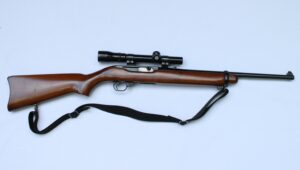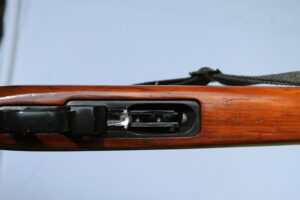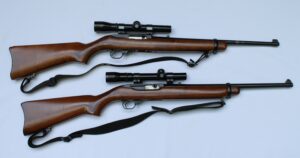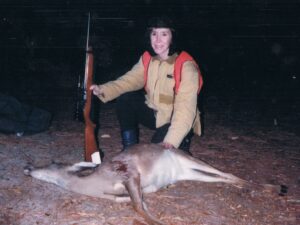
By Jim Dickson | Contributing Editor
Back in pioneer days the .44 caliber was a popular choice for Kentucky rifles.
In 1860 the Henry repeater modernized this with a lever action repeating rifle firing a .44 rimfire 200-grain bullet at 1150 FPS. The Winchester M1866 further popularized the caliber. In 1873 the improved M1873 Winchester gave the .44 caliber a new lease on life with the more powerful .44-40 Winchester centerfire cartridge which went on to kill more North and South American game of all kinds than any caliber since due to the timing of its arrival on the frontier. The M73 was followed by the improved M1892 Winchester in the same caliber and there things stayed until Bill Ruger decided the time was right to bring the .44-caliber rifle into the 20th Century.
The .44-40 had been outclassed by the then new .44 Magnum and Ruger was already building single action revolvers for this caliber. Instead of a lever action, Ruger took his inspiration from the M1 carbine that had proved itself in WW2 and the Korean War while endearing itself to the troops for its handling qualities. Unlike the M1 carbine the new Ruger carbine retained the tubular magazine of the lever action rifles that preceded it. The new gun held 5 rounds. One in the chamber and four in the magazine. A semi-auto utilizing a short stroke gas piston and rotary locking lugs it weighed in at 5.75 pounds and was 36.75 inches long. It’s 18 ¼-inch barrel was rifled with a twist of one turn in 38 inches.

Two areas where Ruger should have copied the M1 carbine more closely were the front barrel band and the trigger mechanism. The M1 carbine front barrel band is retained by a spring latch whereas the new Ruger had the cheaper and inferior method of just tightening the front band screw.
The trigger of the M1 carbine is simple, rugged, and easy to work on. When I bought a Ruger .44 Magnum carbine in the 1980s it came with a terrible trigger pull. The best Army Ordnance trigger specialist alive at that time refused to touch it. Likewise, Chief AJ who made a living accurizing and tuning Ruger firearms. When I called the Ruger factory they said two men at the Ruger factory were the only men in the country that could work on that trigger so I sent it back to the factory. That trigger may be cheap to mass produce but one that can’t be worked on by any good gunsmith is not my idea of a good design.
A flaw the Ruger carbine shares with the M1 carbine is that both must be cleaned from the muzzle where the rifling can eventually be damaged causing accuracy to suffer. Army Ordnance used to make their own brass muzzle guides for cleaning the M1 Garand and M1 carbine. Fortunately, J. Dewey Mfg. Co., Inc. in Southbury Connecticut makes brass cleaning rod guides for .44 caliber guns as well as all other calibers. It is important to use these when cleaning any gun from the muzzle.
The first prototype was made in 1959 and the gun went into production in 1960. Originally named the “Deerstalker” that was dropped when Ithaca objected saying it sounded too much like their “Deerslayer” shotgun name. Every type of North American game has been killed by .44 magnum revolvers but the cartridge really came into its own as a rifle caliber with the extra velocity it got from the 18 ½-inch rifle barrel. The jacketed 240-grain bullets coming out of the barrel at 1,825 FPS were thought by many to kill better than the .30-06 within 100 yards. This belief was well founded. I have a WW2 army manual that states bluntly that the .45ACP has more stopping power than the .30-06 so why wouldn’t a .44 magnum out of a rifle have more stopping power on game than a .30-06? The gun could easily range out to 200 yards and I don’t believe in shooting game at longer ranges than that as the risk of just wounding increases proportionately with the range with any gun.
It is important to only use jacketed bullets in this gun as lead bullets are torn up at the velocity the 18 ½-inch barrel imparts to them plus the gas port in the barrel will shave lead until it jams on the shavings.
I always used 240-grain jacketed hollowpoints for deer and I had some 240-grain FMJ semi-wadcutters loaded for use on bear and moose. You already have a big enough hole. You need penetration on big game, not expansion that limits the penetration.
Like its predecessors, the Winchester 73 and 92 in .44-40, the new Ruger was an all-round game getter as it could kill small and medium size game without ruining a lot of the meat yet still had the power for anything in North America. For a subsistence hunter who needs something for his dinner this is critical. High velocity rounds ruin too much meat for smaller prey so you are limiting your dinner menu when you take them afield. The pistol caliber rounds are the only true all round cartridges for the man trying to feed his family with his gun. This was well understood in the old days but like much of the old knowledge it seems to be largely forgotten today. Until you have actually been a subsistence hunter you cannot fully appreciate how important this versatility is. You have to be able to take everything from a squirrel or rabbit to a deer or moose or bear. The Ruger .44 Magnum carbine was not only superb at that it was lightweight, compact, and didn’t kick. Even its ammo was compact. All this is important to a man far from civilization hunting for his dinner instead of shopping for it at a grocery store.
There is another important reason to use the .44 Magnum on small and medium game. Ever since the
.22 was first used on game there have been many conscientious hunters that adhere to the respect for the game traditions of the European hunter and the American Indian that have condemned the .22 as inhumane on game. Its lack of killing power often means a prolonged death that may well include escaping down a hole to die unrecovered by the hunter. The .44 Magnum does not ruin much meat and offers a quick and humane kill. That also means a better chance of coming home with dinner for the family.
Felt recoil was very light and the gun was extremely pleasant to shoot. So much so that when Betty got ahold of that gun she started shooting it like it was a .22 which got expensive really fast. Fortunately, Ruger made a companion .22 look-alike, the Ruger 10/22. I had to get one and put an identical 2.75X Redfield scope on it quick.

Not only was the .44 Magnum carbine fun to shoot is was plenty accurate for hunting. Most will group inside 3½ inches at 100 yards and because the bullet is stabilizing fast at that range they do not expand the group that much at 200 yards. Plenty of accuracy for shooting a deer in the woods where most deer are shot at 50 yards or less. There just aren’t that many places in the woods where you can see much further than that.
The handling qualities were not quite up to its inspiration, the M1 carbine, but were better than the lever rifles that had ruled the woods before it. It also had more knock down power and less kick than the .30-30 Winchester. Light and easy to carry it soon became extremely popular as a woods rifle.

When Betty and I had Alaskan trapper’s licenses we saw them carried for bear protection in Alaska. The .44 Magnum had already proved itself on grizzly bears when fired from a pistol and the round had more power when fired from a rifle and could be fired faster as the carbine has negligible recoil while the .44 Magnum pistol is extremely slow for second shots because of heavy recoil. Still the pistol was getting the job done. I had a friend who was in Northern Alaska skinning out a caribou he had shot when he turned and saw a polar bear stalking him a few feet away. He did a fast draw and killed the beast with his .44 Magnum revolver.
The .44 Magnum semi-auto carbine proved to be one of the best balanced combinations of power with minimum recoil available. Combined with its light weight and splendid handling qualities it was one of the finest woods rifles of the 20th Century. People who used it quickly fell in love with it. It delivered the goods in the hunting field surpassing all expectations.
The day of the semi-auto had arrived. No longer would the average American hunting rifle be either a bolt or lever gun. A modern third type had made itself known. It’s rapid-fire capability made the lever actions look slow by comparison and proved an effective answer to the white tailed deer’s famous trick of doing the 100 yard dash when heart shot to die in front of another hunter’s stand. Its short length was handy in thick brush where full length guns were more likely to hang up on brush when they had to be mounted fast while it’s light weight made it easy to carry all day.
Ruger made the .44 Magnum carbine in Southport from 1959 to 1979 and in Manchester from 1969 to 1985. About 250,000 were made and it was still selling well when it was discontinued. One of the best woods hunting rifles ever made was thus denied to hunters. There has been nothing before or since to take its place.



